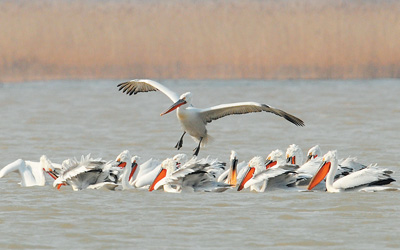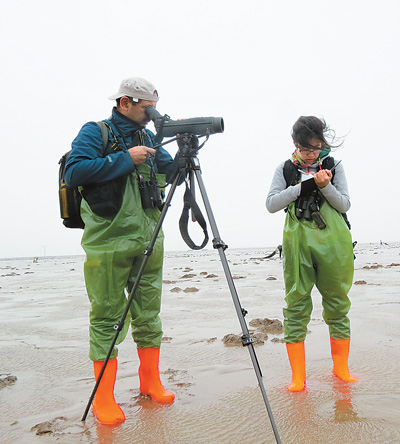


Dalmatian pelicans at the Yellow River Delta National Nature Reserve (Photo/Liu Yueliang)
Located in Dongying of Shandong province, the Yellow River Delta National Nature Reserve covers an area of 153,000 hectares. The reserve is an important breeding and transit area for migrant birds. In recent years, more and more birds have traveled through the area thanks to wetland protection and restoration.
"Reeds release ten times more oxygen than forest trees," a reserve guide said. Reeds have become a perfect playground for birds. In winter, the reeds will be cut to prevent fires.
At present, some six million birds of 368 species travel through, breed, and rest at the reserve every year. Wild ducks, oriental white storks, whooper swans, wild geese, egrets, dalmatian pelicans, great bustards, red-crowned cranes, and other species all enjoy the good ecosystem here. The number of oriental white storks, which is under first class protection, has increased to 741, and the number of black-headed gulls has surpassed 10,000.

Migrant birds at the Yellow River Delta National Nature Reserve (Photo/Liu Yueliang)
The nature reserve has reserved the best land along the Yellow River for birds. A land control policy is implemented to require farmers to grow grain crops like winter wheat. When harvest season comes, three-five percent of the grains have to remain on the land to provide food and shelter for the migrant birds.
In addition, to reduce the interference of human activities on birds, the reserve's densely birded area, feeding area, and core reserve area are closed to humans. Closed-end management is introduced to prohibit human activities.

Workers observe the birds at the Yellow River Delta National Nature Reserve (Photo/Zhao Yajie)
The reserve's wetland is the product of waters from the sea and the Yellow River. Based on the Yellow River's water and sand resources, 20,000 mu (about 1,333 hectares) more wetland will be formed toward the Bohai Sea each year. However, the newborn wetland is fragile and unstable. To protect and restore the wetland, the reserve has built dams to store water and reduce alkali and salt. After more than ten years' effort, the vegetation area in the reserve has increased by ten percent, making it China's largest coastal natural vegetation area.
 Fire brigade in Shanghai holds group wedding
Fire brigade in Shanghai holds group wedding Tourists enjoy ice sculptures in Datan Town, north China
Tourists enjoy ice sculptures in Datan Town, north China Sunset scenery of Dayan Pagoda in Xi'an
Sunset scenery of Dayan Pagoda in Xi'an Tourists have fun at scenic spot in Nanlong Town, NW China
Tourists have fun at scenic spot in Nanlong Town, NW China Harbin attracts tourists by making best use of ice in winter
Harbin attracts tourists by making best use of ice in winter In pics: FIS Alpine Ski Women's World Cup Slalom
In pics: FIS Alpine Ski Women's World Cup Slalom Black-necked cranes rest at reservoir in Lhunzhub County, Lhasa
Black-necked cranes rest at reservoir in Lhunzhub County, Lhasa China's FAST telescope will be available to foreign scientists in April
China's FAST telescope will be available to foreign scientists in April "She power" plays indispensable role in poverty alleviation
"She power" plays indispensable role in poverty alleviation Top 10 world news events of People's Daily in 2020
Top 10 world news events of People's Daily in 2020 Top 10 China news events of People's Daily in 2020
Top 10 China news events of People's Daily in 2020 Top 10 media buzzwords of 2020
Top 10 media buzzwords of 2020 Year-ender:10 major tourism stories of 2020
Year-ender:10 major tourism stories of 2020 No interference in Venezuelan issues
No interference in Venezuelan issues
 Biz prepares for trade spat
Biz prepares for trade spat
 Broadcasting Continent
Broadcasting Continent Australia wins Chinese CEOs as US loses
Australia wins Chinese CEOs as US loses